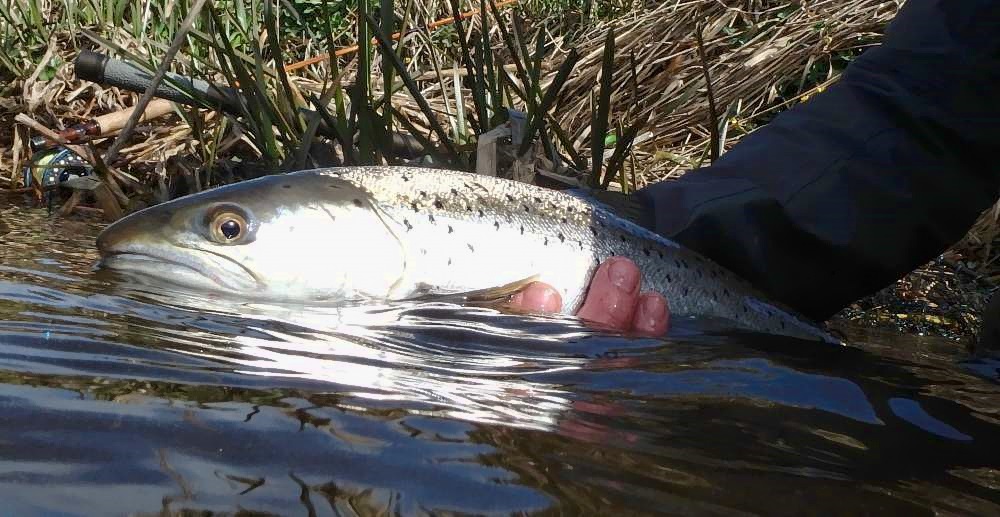Hi Rob
There are a number of reasons for the pass.
On the River Dee, there are several types of obstructions that have partially or completely
obstructed salmonid migration on some of its tributaries. Tributaries are essential to support the
abundant salmon in main-stem rivers as it is the top ends of tributaries that often provide the best
spawning areas for salmon. In Scotland, obstructions which do not allow passage for migrating
salmonids contravene regulations concerning the safe passage of migratory fish (The Salmon
(Fish Passes and Screens) (Scotland) Regulations 1994) and require that either a fish pass be
installed or the obstruction removed. (from the Dee Obstruction report)
Secondly, you are correct, there are some areas of poor habitat, but there are also some areas which are excellent, and much work has already been completed to improve over shading, forestry and fencing issues and silting. I understand that fish do pass the weir, but only in extreme conditions and once there the parr survival is good. When i asked the question of the Dee office they sent me this through, it answers the question far better than i did!
It was prepared by Adrian Hudson, our biologist, another of his excellent papers!
Electric fishing surveys of juvenile fish stocks within the Coy Burn have been carried out for some years now. Habitat surveys have also been carried out on most of the burn. Combining these two survey techniques makes it possible to estimate the potential smolt output that could be gained to the River Dee system if a fish pass was installed in the currently impassable dam.
Electric fishing juvenile surveys in the area of the Coy Burn below the dam have shown average densities of 87.76 salmon parr in a hundred square metres. This extraordinarily high density (10 parr per hundred square metres is considered good) makes the Coy Burn one of the most productive in the Dee catchment.
Unfortunately, not all of the Coy Burn system above the dam has as good instream habitat as that found below. The system above the dam can be divided into three main sections, based on land use and instream habitat types:
Coy Burn to the bottom of the Loch of Park area: 30,200 m2 available. Of this, approximately 500 m2 is good habitat for salmon, and a further 1000 m2 is poor or moderate. The rest is currently unsuitable. Assuming parr densities equivalent to that below the falls on the good habitat, and at 50% on the poor and moderate habitat, this would generate an extra 878 salmon parr.
Loch of Park to Crathes Castle dam: 16,200 m2 available. Of this, approximately 9,000 m2 is good habitat, and a further 3,000 m2 is poor or moderate. Assuming parr densities as above, this would generate an extra 9,216 salmon parr.
Corrichie Burn (a large sub-tributary of the Coy Burn): 7800 m2 available. Of this approximately 6000 m2 is good habitat, but the water quality is not quite as productive as the Coy Burnís mainstem (the Corrichie Burn runs off the Hill of Fare, heather moorland with extensive coniferous forestry plantations). Electric fishing juvenile surveys would suggest that it could support approximately two-thirds of the parr densities fond below the dam. This would generate an extra 3,510 parr.
Combining these three areas gives a total production of 13,604 salmon parr.
The Coy Burn salmon parr grow very quickly and go out as 2+ smolts. Because of this, only 1+ parr are caught during electric fishing surveys and it is not possible to calculate parr survival figures. If it is assumed that there is 50% mortality over winter, as is true in areas of good habitat that produce 3+ smolts, this parr population would lead to a smolt run of around 6,800.
Before answering i checked with the Dee Project Biologist and Bailif manager and both agreed this one is a good one to improve early on as it will provide a good return for the work carried out, both in terms of seatrout and salmon.
D
As for the amphbians, i did not ask about them but the answer to questions I have asked about similar situations is that man made changes to habitat have favoured some species and damaged others but easing these changes allows the habitat and the species in it to return to a more normal state.

